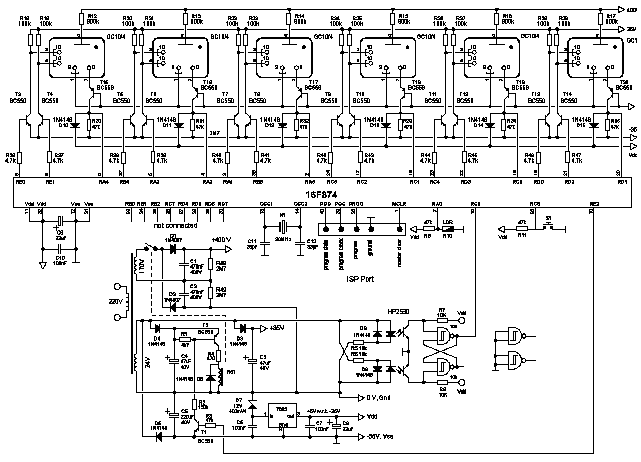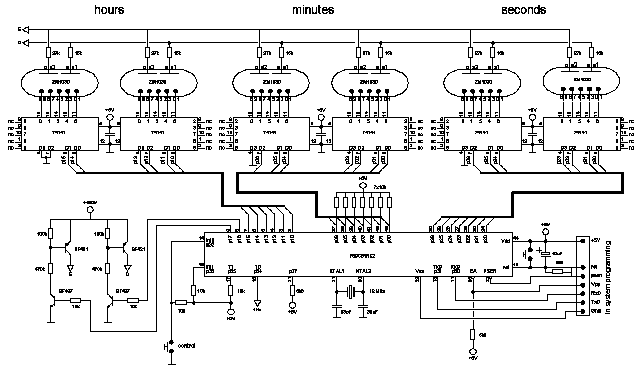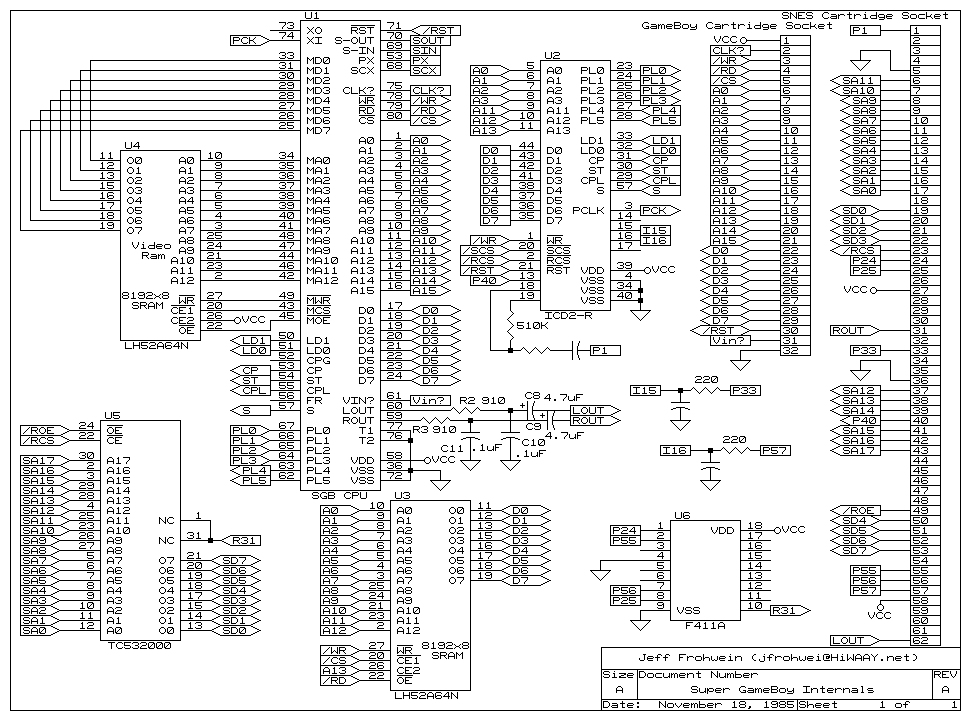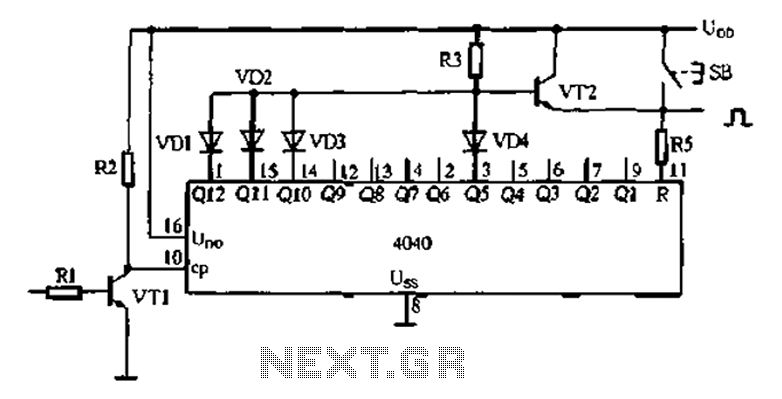
Geerts clock

A single beautiful giant ZM1042 NIXIE tube was acquired from Jim Oostveen, leading to the idea of constructing a single-digit NIXIE clock for Geert. The ideal case for this clock was found at a local IKEA store: a wooden frame measuring 14x19x8 cm, featuring a glass front and a white hardboard back. Following a random color design created for Jan Verhoeven's farewell gift, the concept of integrating an ambient light feature with the NIXIE clock emerged. The popularity of the Philips "ambi-light LCD" TV raised questions about consumer preferences for color experiences, despite the designer's color blindness. However, Geert appreciated the idea. The designer considered deriving the high voltage for the NIXIE tubes directly from the mains, eliminating the need for a high voltage transformer or switch-mode power supply, although this requires careful precautions. The intention was to implement a fading effect for the digits in the NIXIE tube, creating a visually striking appearance reminiscent of gas lighting. Directly connecting a clock to the mains poses significant dangers, as explained in the subsequent sections. A simplified schematic illustrates the power distribution grid supplying a transformer-connected appliance, highlighting the importance of safety measures when dealing with mains-fed circuits.
The proposed NIXIE clock circuit utilizes a giant ZM1042 tube, known for its aesthetic appeal and unique display characteristics. The design incorporates a wooden frame sourced from IKEA, providing an elegant enclosure. The integration of ambient lighting is a notable feature, drawing inspiration from successful color-changing technologies in consumer electronics. This ambient light feature enhances the visual experience, creating a dynamic interaction with the NIXIE display.
In the circuit design, the high voltage required for the NIXIE tubes is derived directly from the mains supply. This approach necessitates stringent safety precautions to mitigate the inherent risks associated with mains-powered devices. The circuit must include proper isolation techniques and protective components to prevent accidental contact with high voltage areas. Additionally, the fading effect of the NIXIE digits is achieved through a controlled modulation of the power supplied to the tube, employing a suitable driver circuit that can handle the high voltage and provide the necessary timing control.
The safety considerations are paramount, as the direct connection to the mains means that any fault condition could result in dangerous situations. The circuit design must ensure that the high voltage components are adequately insulated and that the user is protected from any potential electrical hazards. Implementing a transformer or isolation mechanism, while adding complexity, significantly enhances the safety of the design.
This comprehensive approach not only focuses on the aesthetic and functional aspects of the NIXIE clock but also emphasizes the importance of safety in the design of high voltage electronics. The combination of innovative lighting effects and careful engineering creates a unique and visually appealing timekeeping device that respects the principles of electrical safety.Happened to have in my NIXIE collection a single beautiful giant ZM1042 (for the record, I got it from Jim Oostveen). For me it was obvious that a single digit NIXIE clock built around this tube would be just the thing for Geert.
Some time ago, while visiting our local IKEA store, I found just the perfect case for the clock: a 14x19x8 cm wooden frame with a glass window front and a white hardboard back. It was just after I made the random color design for Jan Verhoevens farewell present, and it seemed a nice idea to combine the single tube NIXIE clock with an ambient light feature. Personally I am completely mystified by the success of the Philips "ambi-light LCD" TV. I work at Philips Research myself, and I would never have believed that somebody would pay extra money for a TV that projects a colorful aura on the wall behind the TV, but the fact is there.
Also the positive reactions I got on Jan Verhoevens color changing farewell clock, let me to the conclusion that colors are very important to people. I myself am totally color blind, so unfortunately I will never be able to appreciate this. But, Geert is not color blind, and he thought it was a great idea! For some time now I have been playing around with the idea to make a clock in which the high voltage for the NIXIE tubes is derived directly from the mains, without the need for an high voltage transformer or switch-mode power supply.
Since there was only very little space in the wooden case that I had in mind for this clock, I decided to use it for Geert`s clock. Connecting a clock directly to the mains requires some special precautions, which will be explained in one of the next sections.
To make the clock even more interesting I wanted to make the digits in the NIXIE tube to fade slowly on and off. Especially for these giant NIXIE tubes the effect is very striking. It looks as if the digits are gas lit! In a circuit which is directly fed from the mains, the circuit is connected via a direct galvanic connection to the mains.
Before I start with the description of the clock circuit, I have to explain why directly mains fed circuits are so dangerous, much more dangerous than circuits that use the same high voltage but derived from a transformer. Figure 1 shows a simplified schematic drawing of the final part of the power distribution grid that delivers the power to your home, connected to an appliance that uses a transformer.
Lets for the sake of this example assume that it is a 240V to 180V transformer used to feed the NIXIE tubes. In the last distribution station the high voltage from the power grid is transformed down to e. g. 240V, the mains voltage we have in Europe. The power is delivered through two wires. One of these wires is called the "life wire" or the "phase wire". The return wire is called the "null" or "ground" wire. It is important to note that at the distribution station the ground wire is connected to ground, that is the ground that you are standing on!
When any part of the circuit at the secondary side of the transformer is accidentally touched, nothing happens since there is no path for the current to flow to ground. The ent 🔗 External reference
The proposed NIXIE clock circuit utilizes a giant ZM1042 tube, known for its aesthetic appeal and unique display characteristics. The design incorporates a wooden frame sourced from IKEA, providing an elegant enclosure. The integration of ambient lighting is a notable feature, drawing inspiration from successful color-changing technologies in consumer electronics. This ambient light feature enhances the visual experience, creating a dynamic interaction with the NIXIE display.
In the circuit design, the high voltage required for the NIXIE tubes is derived directly from the mains supply. This approach necessitates stringent safety precautions to mitigate the inherent risks associated with mains-powered devices. The circuit must include proper isolation techniques and protective components to prevent accidental contact with high voltage areas. Additionally, the fading effect of the NIXIE digits is achieved through a controlled modulation of the power supplied to the tube, employing a suitable driver circuit that can handle the high voltage and provide the necessary timing control.
The safety considerations are paramount, as the direct connection to the mains means that any fault condition could result in dangerous situations. The circuit design must ensure that the high voltage components are adequately insulated and that the user is protected from any potential electrical hazards. Implementing a transformer or isolation mechanism, while adding complexity, significantly enhances the safety of the design.
This comprehensive approach not only focuses on the aesthetic and functional aspects of the NIXIE clock but also emphasizes the importance of safety in the design of high voltage electronics. The combination of innovative lighting effects and careful engineering creates a unique and visually appealing timekeeping device that respects the principles of electrical safety.Happened to have in my NIXIE collection a single beautiful giant ZM1042 (for the record, I got it from Jim Oostveen). For me it was obvious that a single digit NIXIE clock built around this tube would be just the thing for Geert.
Some time ago, while visiting our local IKEA store, I found just the perfect case for the clock: a 14x19x8 cm wooden frame with a glass window front and a white hardboard back. It was just after I made the random color design for Jan Verhoevens farewell present, and it seemed a nice idea to combine the single tube NIXIE clock with an ambient light feature. Personally I am completely mystified by the success of the Philips "ambi-light LCD" TV. I work at Philips Research myself, and I would never have believed that somebody would pay extra money for a TV that projects a colorful aura on the wall behind the TV, but the fact is there.
Also the positive reactions I got on Jan Verhoevens color changing farewell clock, let me to the conclusion that colors are very important to people. I myself am totally color blind, so unfortunately I will never be able to appreciate this. But, Geert is not color blind, and he thought it was a great idea! For some time now I have been playing around with the idea to make a clock in which the high voltage for the NIXIE tubes is derived directly from the mains, without the need for an high voltage transformer or switch-mode power supply.
Since there was only very little space in the wooden case that I had in mind for this clock, I decided to use it for Geert`s clock. Connecting a clock directly to the mains requires some special precautions, which will be explained in one of the next sections.
To make the clock even more interesting I wanted to make the digits in the NIXIE tube to fade slowly on and off. Especially for these giant NIXIE tubes the effect is very striking. It looks as if the digits are gas lit! In a circuit which is directly fed from the mains, the circuit is connected via a direct galvanic connection to the mains.
Before I start with the description of the clock circuit, I have to explain why directly mains fed circuits are so dangerous, much more dangerous than circuits that use the same high voltage but derived from a transformer. Figure 1 shows a simplified schematic drawing of the final part of the power distribution grid that delivers the power to your home, connected to an appliance that uses a transformer.
Lets for the sake of this example assume that it is a 240V to 180V transformer used to feed the NIXIE tubes. In the last distribution station the high voltage from the power grid is transformed down to e. g. 240V, the mains voltage we have in Europe. The power is delivered through two wires. One of these wires is called the "life wire" or the "phase wire". The return wire is called the "null" or "ground" wire. It is important to note that at the distribution station the ground wire is connected to ground, that is the ground that you are standing on!
When any part of the circuit at the secondary side of the transformer is accidentally touched, nothing happens since there is no path for the current to flow to ground. The ent 🔗 External reference





